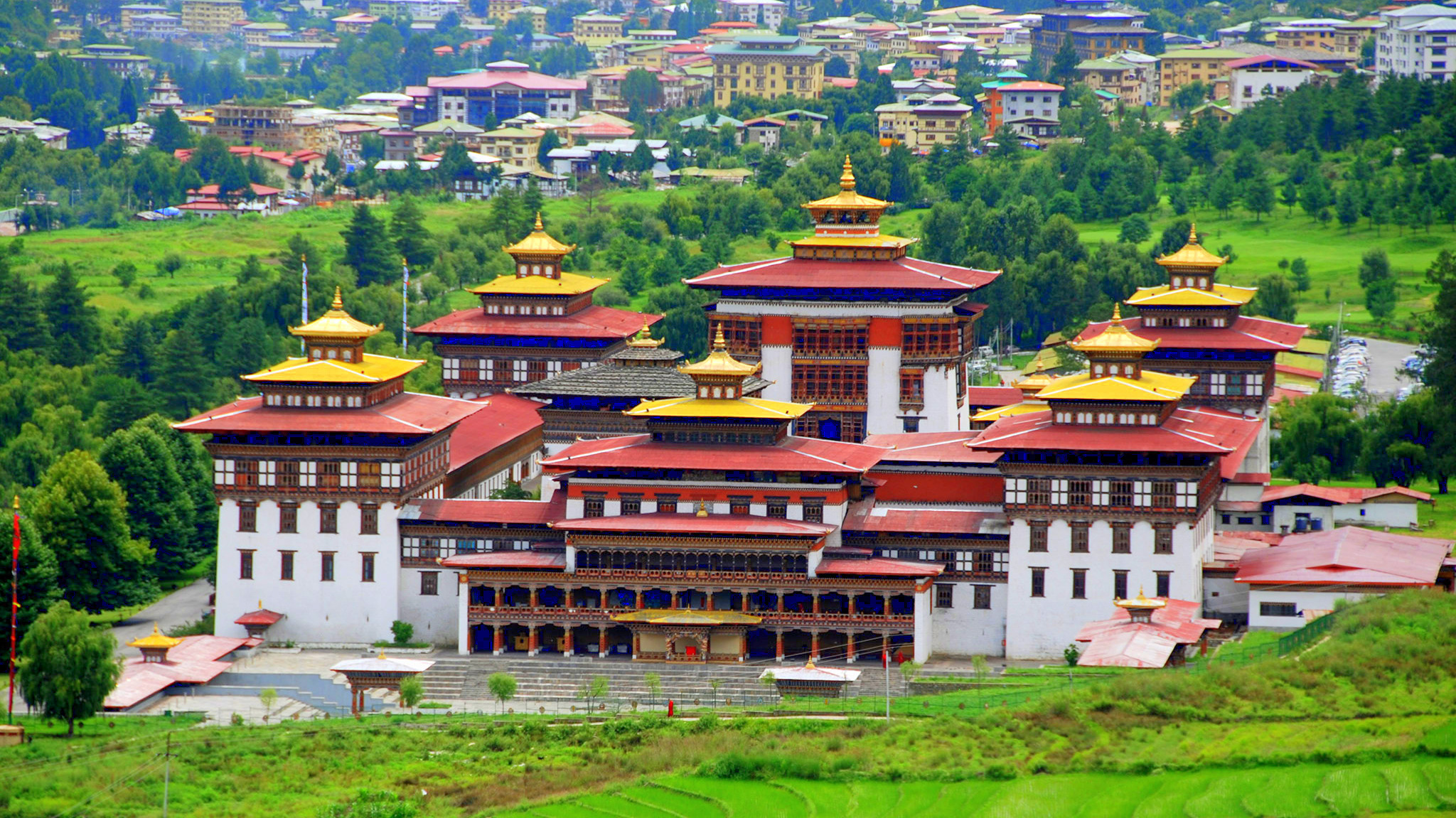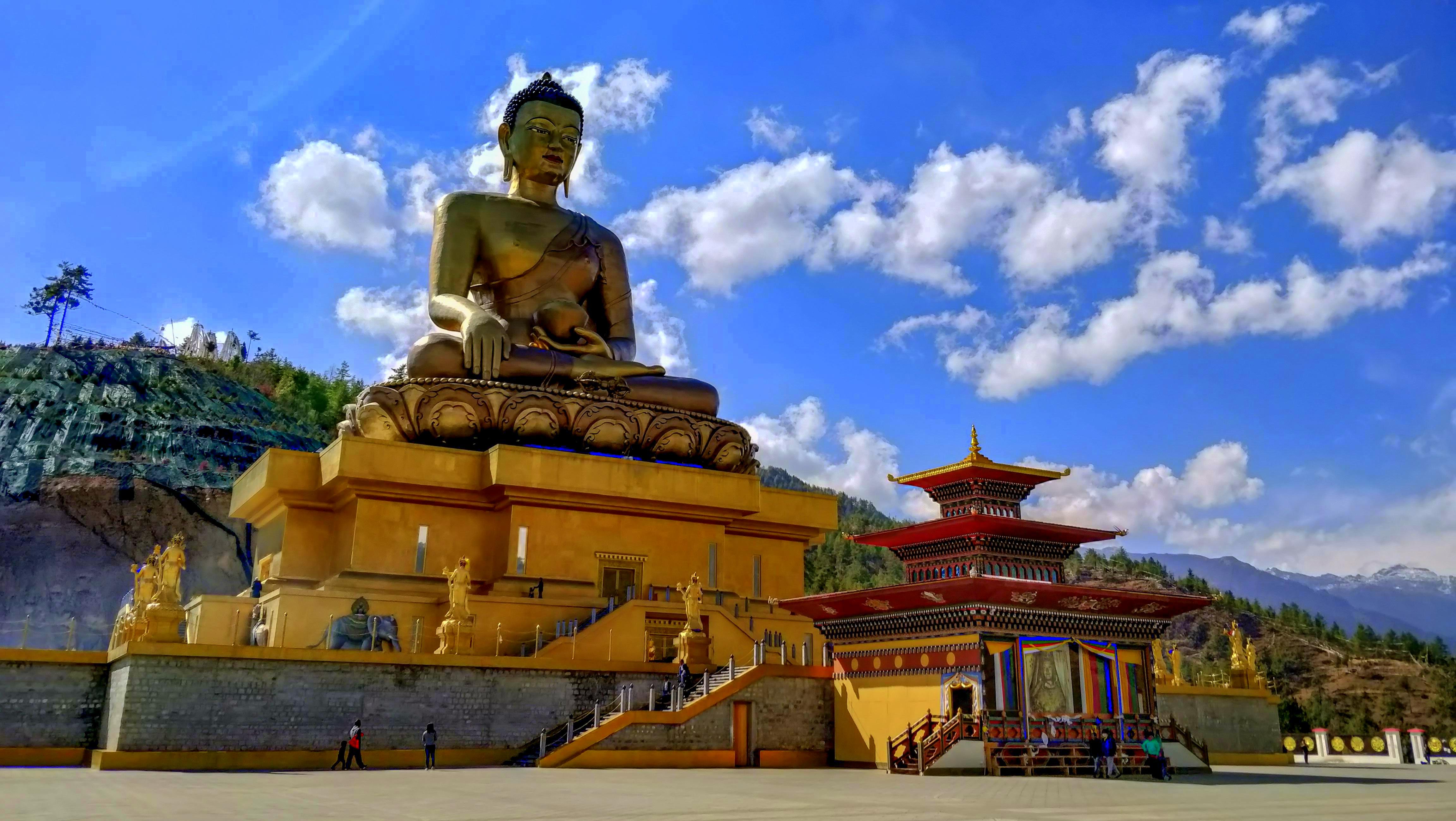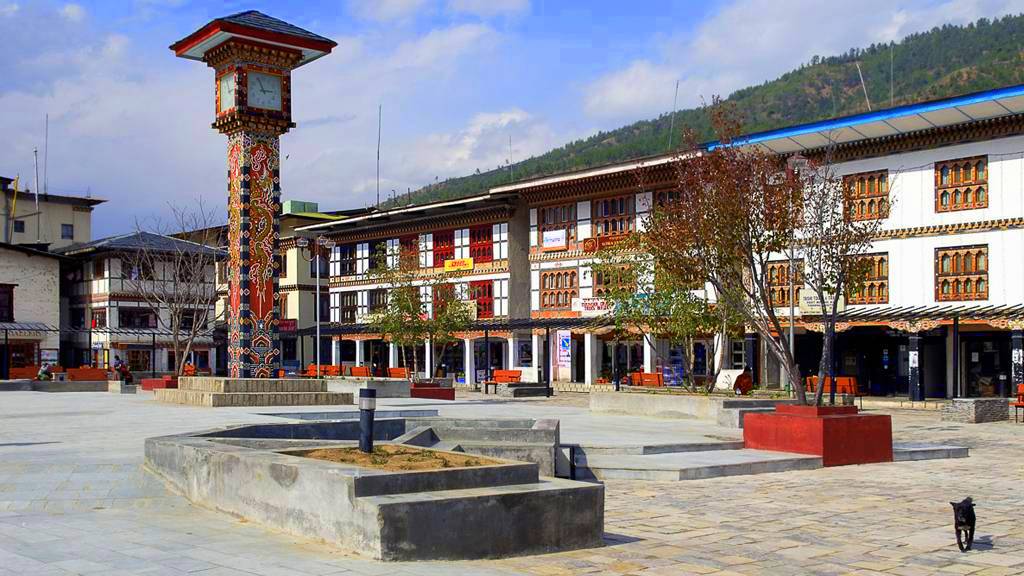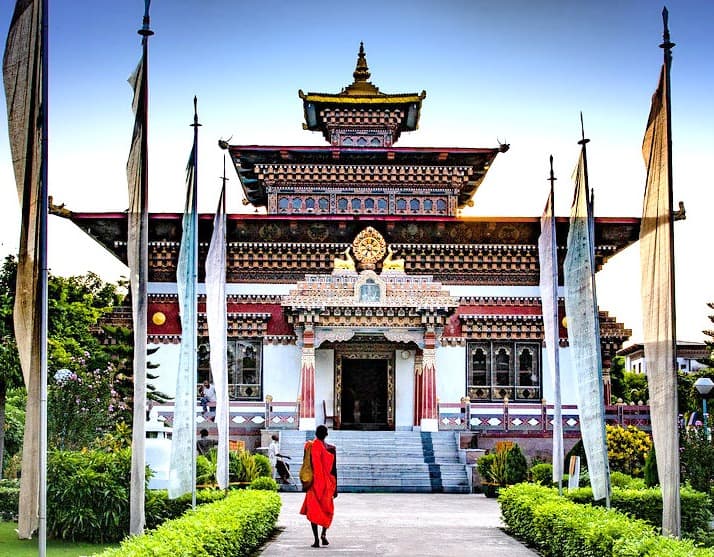Thimphu, the capital of Bhutan, is a city where ancient traditions seamlessly blend with modern life, offering visitors a unique cultural experience. As you explore Thimphu, Bhutan, you’ll discover a range of top tourist spots that showcase the rich heritage and natural beauty of this Himalayan kingdom. From the iconic Tashichho Dzong Thimphu, a fortress that encapsulates Bhutan's political and religious life, to the serene Buddha Dordenma, one of the world's largest Buddha statues offering panoramic views of the valley, Thimphu is filled with remarkable Thimphu attractions. Don't miss the National Memorial Chorten Thimphu, a key site of worship and remembrance, or the Motithang Takin Preserve where the unique national animal of Bhutan can be observed. For a deeper understanding of the local culture, the Folk Heritage Museum Thimphu and the Royal Textile Academy offer insights into traditional Bhutanese life and arts. Whether you're interested in Thimphu sightseeing, immersing in Thimphu cultural sites, or discovering the best places to visit in Thimphu, this guide provides all the information needed to make your visit unforgettable.
At Druk Holidays, we pride ourselves on being the premier choice for discovering the best places to visit in Thimphu. With our deep-rooted knowledge and passion for Bhutan's rich heritage, we curate experiences that are not just tours, but transformative journeys. Whether you're exploring the grandeur of Tashichho Dzong Thimphu, seeking blessings at the sacred Changangkha Lhakhang, or delving into the artistic traditions at the Royal Textile Academy, Druk Holidays ensures a seamless and enriching experience. Our expert guides bring Thimphu’s stories to life, making us the top choice for those looking to explore Thimphu, Bhutan with authenticity and depth. Join us to experience why Druk Holidays is renowned for offering the best in Thimphu sightseeing and cultural exploration.
Tashichho Dzong
Tashichho Dzong is one of the most iconic landmarks in Thimphu, Bhutan. Known for its impressive architecture and significant role in the administrative and religious life of the country, this fortress is a blend of history, culture, and governance.

- Historical Significance: Originally constructed in 1641 and rebuilt in the 1960s after a fire, Tashichho Dzong has been the traditional seat of the Druk Desi, the head of Bhutan's civil government, an office which has been combined with the kingship since the creation of the monarchy in 1907. The dzong serves as the summer residence of the Je Khenpo, the Chief Abbot of the Central Monastic Body of Bhutan.
- Architectural Marvel: The dzong is a stunning example of Bhutanese architecture, featuring intricate woodwork and beautiful frescoes that reflect the Buddhist culture deeply embedded in the country. The structure is massive, yet elegantly proportioned, with towering whitewashed walls that stand out against the backdrop of the blue sky and lush greenery.
- Administrative and Religious Hub: Tashichho Dzong houses the throne room and offices of the King of Bhutan, making it a central point of governance. It also accommodates various government offices and the Central Monastic Body, which makes it a vital religious center. This dual function reflects the Bhutanese ideal of blending civic and spiritual governance.
- Cultural Significance: The dzong is not just a tourist attraction but also a living museum and a vibrant center of power, religion, and events. One of its major cultural events is the Thimphu Tshechu, held annually in its courtyard. This festival attracts thousands of locals and tourists who come to witness the colorful mask dances, prayer ceremonies, and other cultural displays that are an integral part of Bhutanese culture.
- Visiting Tashichho Dzong: Visitors to Tashichho Dzong can enjoy guided tours that explain the history and function of the dzong in the Bhutanese state. The best time to visit is late afternoon when the setting sun casts golden hues on the fortress, enhancing its grandeur. Photography is allowed in the courtyard but restricted inside the administrative and religious buildings.
Tashichho Dzong is not just a fortress; it is a testament to Bhutan's rich heritage and its ongoing journey blending the old with the new. It stands as a pillar of the nation's past and present, making it a must-visit for anyone traveling to Thimphu.
Buddha Dordenma
Buddha Dordenma stands majestically over Thimphu, the capital of Bhutan, symbolizing the prevalent peace and stability. This monumental statue is not only a key highlight in Thimphu sightseeing but also a spiritual nexus for both locals and tourists.

- The Statue's Grandeur: Erected to celebrate the 60th anniversary of the fourth king Jigme Singye Wangchuck, the Buddha Dordenma is one of the largest Buddha statues in the world, standing at a height of 51 meters. It is made of bronze and gilded in gold, making it a striking figure against the backdrop of the verdant Himalayan Mountains.
- Symbolic Significance: The statue houses over 125,000 smaller Buddha statues, each also made of bronze and gilded in gold, symbolizing an embodiment of peace and a reminder of the Buddha's teachings on compassion and goodwill. The Buddha Dordenma is seen as a guardian over the capital and is believed to emanate an aura of peace and happiness to the entire world.
- Location and Surroundings: Situated atop a hill in Kuenselphodrang Nature Park, the site offers panoramic views of the Thimphu Valley. The location is not only chosen for its commanding views but also for its spiritual significance, believed to fulfill an ancient prophecy dating back to the 8th century A.D. that stated a large statue of either Padmasambhava or Buddha would be built in the region to bestow blessings, peace, and happiness on the whole world.
- Cultural and Tourist Attraction: The Buddha Dordenma is a major Thimphu attraction, drawing visitors from all over for both its spiritual significance and architectural grandeur. The site provides a peaceful space for reflection and meditation, appealing to spiritual seekers and those simply wishing to escape the hustle and bustle of the city below.
- Visiting Tips: For the best experience, visit during the early morning or late afternoon when the sunlight enhances the statue’s golden hue. Additionally, several cultural and religious festivities occur at the site throughout the year, providing visitors with a deeper insight into Bhutanese culture and spirituality.
Overall, the Buddha Dordenma is not just an impressive physical structure but a profound symbol of peace and protection, reflecting the deep spiritual roots of Bhutanese culture and offering a unique, serene experience to all who visit.
National Memorial Chorten
National Memorial Chorten stands as a profound symbol of peace and a poignant reminder of Bhutan's spiritual heritage in the heart of Thimphu. Erected in memory of the third King of Bhutan, His Majesty Jigme Dorji Wangchuck, this chorten is not only a monument but a vibrant center of daily worship and a gathering place for faithful Bhutanese.

- Historical Background: The National Memorial Chorten was conceived by the third King himself as a monument to world peace and prosperity, but he passed away before its realization. It was subsequently built in 1974 in his memory by his mother, Her Majesty the Royal Grandmother Ashi Phuntsho Choden Wangchuck. It has since become a focal point of devotion for the people of Bhutan.
- Architectural Significance: Featuring a classic stupa design, the chorten is marked by richly carved annexes facing the cardinal directions, and an elaborate mandala painted on the ceiling. Whitewashed walls and golden spires reflect the traditional Bhutanese style, making it a striking feature against the city’s backdrop. Its design incorporates both Tibetan and Bhutanese artistic elements, making it a significant architectural landmark in Thimphu.
- Cultural and Religious Importance: The National Memorial Chorten is more than just a Thimphu attraction; it is a living place of worship. Every day, it is thronged by elderly Bhutanese who come to circumambulate the chorten, spinning its large prayer wheels and chanting mantras. The structure embodies the teachings of the Nyingma sect of Tibetan Buddhism and serves as a hub for religious teachings and gatherings.
- A Hub for Social and Spiritual Gatherings: This chorten not only serves a spiritual function but also acts as a social venue where people, especially the elderly, meet and interact. Festivals and religious occasions see it come alive with energy, with the most notable being the annual Memorial Chorten Festival, which attracts people from all over the country.
- Visiting the Chorten: Visitors to the National Memorial Chorten can observe and even participate in these daily rituals, offering a unique glimpse into the spiritual life of the Bhutanese people. The chorten is open to tourists, and guides are often available to explain the iconography and significance of the rituals performed here.
The National Memorial Chorten is not just a monument to visit but a vibrant testament to the spiritual depth and cultural vitality of Bhutan. Its ongoing role in the daily lives of the Bhutanese makes it a must-visit for anyone looking to understand the essence of Bhutanese faith and community spirit.
Motithang Takin Preserve
Located in the outskirts of Thimphu, the Motithang Takin Preserve is dedicated to the protection and study of the Takin, Bhutan’s national animal. This unique wildlife reserve offers a rare opportunity to see these unusual creatures up close and learn about their behavior and habitat in a natural setting.

- Origin and Purpose: The preserve was originally established as a mini-zoo. However, when the King of Bhutan decreed that it was improper for Bhutan to confine animals for display, the animals were released. Interestingly, the Takin refused to wander off into the wild and remained near the area. As a result, the facility was transformed into a preserve to care for these animals while allowing them to roam freely in a semi-natural environment.
- The Takin: Bhutan's National Animal: The Takin is a curious-looking animal, often described as having the body of a cow and the head of a goat. Its unique appearance has given rise to various local myths and legends, particularly about its creation by the divine madman, Lama Drukpa Kunley. The animal is not only culturally significant but also a symbol of the wilderness of Bhutan.
- Conservation Efforts: The Motithang Takin Preserve is an integral part of Bhutan’s conservation efforts. It provides a safe habitat for Takins, where they can be studied and protected. The preserve plays a crucial role in educating the public and raising awareness about the importance of wildlife conservation in Bhutan.
- Visiting the Preserve: Visitors to the preserve can walk along the enclosed pathways to view the Takins in their natural habitat. Informational signs provide insights into the Takin’s behavior, diet, and the conservation efforts underway to protect them. The serene environment also offers a pleasant retreat from the more urban atmosphere of Thimphu.
- Educational and Tourist Attraction: For those interested in wildlife and conservation, the Motithang Takin Preserve is a must-visit. It’s not only a chance to see the national animal but also to learn about Bhutan's commitment to preserving its natural heritage. The preserve’s location near Thimphu makes it an easily accessible stop for tourists looking to experience a different facet of Bhutanese culture and environmental stewardship.
Motithang Takin Preserve serves as both a sanctuary for the Takin and a center for environmental education. It highlights Bhutan's dedication to conservation and offers a unique wildlife experience that is deeply rooted in the country's cultural and natural heritage.
Folk Heritage Museum
The Folk Heritage Museum in Thimphu offers a unique glimpse into the traditional lifestyle of the Bhutanese people, providing an educational and engaging experience for both locals and visitors. Situated in a restored three-story traditional house, this museum is a testament to Bhutan's rich cultural heritage and its commitment to preserving its history.

- Historical and Cultural Significance: The museum was established to connect people to the Bhutanese rural past through exhibits, demonstrations, educational programs, and documentation of rural life. The building itself is a traditional rammed earth and timber house, which is over a century old and reflects the architecture typical of a rural Bhutanese family.
- Exhibits and Displays: Inside, the museum features an array of household objects, tools, and equipment used in rural Bhutanese households. Each artifact tells a story of the daily lives of Bhutanese ancestors, from farming, animal husbandry, and traditional arts and crafts to festivals and religious practices. The museum not only showcases these items but also offers demonstrations of rural traditions, such as traditional cooking, which is particularly popular among visitors.
- Immersive Experiences: One of the highlights of visiting the Folk Heritage Museum is the opportunity to partake in traditional Bhutanese meals prepared using age-old methods. This immersive experience is complemented by the setting within the museum, furnished to mimic the rustic interiors of a typical Bhutanese home. It offers a tactile connection to the past, allowing visitors to sit on traditional wooden beds and use typical utensils.
- Educational Programs: The museum is proactive in its educational outreach, offering programs that teach visitors about Bhutanese agricultural practices, food preparation, and the importance of preserving such cultural elements. These programs are designed to foster a deeper appreciation and understanding of Bhutan's traditional ways of life, which are often overshadowed by the rapid modernization outside the museum walls.
- A Must-Visit Attraction: For tourists looking to deepen their understanding of Bhutan beyond its monasteries and landscapes, the Folk Heritage Museum provides a profound insight into the real, everyday life of traditional Bhutan. It is an essential stop for anyone interested in the history, culture, and traditions of this Himalayan kingdom.
Folk Heritage Museum in Thimphu is more than just a museum; it's a vibrant cultural institution that offers a living history of Bhutanese life. Its authenticity and dedication to preservation make it a pivotal site for cultural preservation and education in Bhutan.
Thimphu Tshechu
Thimphu Tshechu is one of the most vibrant and significant festivals in Bhutan, held in the capital city of Thimphu. This grand festival is not just a religious occasion but a major social and cultural event that draws people from across the nation and international tourists alike.

- Origins and Significance: The Thimphu Tshechu, like other tshechus in Bhutan, was established by the 4th Desi, Gyalse Tenzin Rabgay in 1867. It is primarily a religious festival held on the tenth day of the month of the lunar Tibetan calendar, marking the birth anniversary of Guru Rinpoche (Padmasambhava), the saint who introduced Buddhism to Bhutan. Tshechus are held in his honor to impart blessings, teach the Buddhist dharma, and inspire through exemplar acts depicted in dances.
- Colorful Mask Dances and Rituals: One of the most captivating aspects of the Thimphu Tshechu is the series of mask dances performed by monks and laymen in elaborate, colorful costumes. These dances, known as 'Cham', are not merely entertainments but are considered to be expressions of religious teachings and stories from the life of Padmasambhava. Each dance has a symbolic meaning, often depicting the triumph of good over evil.
- Community and Cultural Interaction: The festival is also a social gathering where Bhutanese people, dressed in their finest traditional attire, come together to witness the religious festivities, socialize, and make merry. It's an occasion that strengthens community bonds and showcases the rich cultural heritage of Bhutan.
- Arts and Crafts Exhibition: Alongside the religious and social festivities, Thimphu Tshechu is also known for its vibrant market atmosphere where local artisans display and sell their crafts. Visitors can find everything from hand-woven textiles to traditional jewelry and handicrafts, providing a glimpse into the artistic talents of the Bhutanese people.
- Experience for Visitors: For tourists, attending the Thimphu Tshechu offers a unique opportunity to witness the rich tapestry of Bhutanese culture and spirituality. It's advisable to attend the festival with a guide who can explain the significance of the dances and rituals observed during the festival. Photographers will find the festival a colorful feast for the eyes, and cultural enthusiasts will appreciate the deep spiritual and historical contexts shared at the event.
Thimphu Tshechu is more than just a festival; it's a living exhibition of Bhutanese culture, faith, and community spirit. Attending the festival is an unforgettable experience that provides deep insights into the spiritual and cultural life of Bhutan. For anyone visiting Bhutan, timing your visit to coincide with the Thimphu Tshechu is highly recommended as it offers a deeper connection with the kingdom's traditions and people.
Clock Tower Square
Clock Tower Square is not just the geographical center of Thimphu, but also the cultural and social heartbeat of the city. This iconic landmark is surrounded by shops, cafes, and offices, making it a popular gathering place for both locals and visitors.

- Architectural and Aesthetic Appeal: The Clock Tower itself features traditional Bhutanese architectural motifs, making it a striking piece of artistry. Its detailed carvings and colorful paintings showcase dragons and other Bhutanese symbols, which represent the protection and purity of the country. The square’s design includes beautifully landscaped areas and seating, providing a pleasant environment for relaxation and social interaction.
- Social and Cultural Hub: Clock Tower Square is a bustling locale where various cultural events take place. From live music performances and art displays to public speeches and seasonal festivals, the square is always alive with activity. It serves as a focal point for celebrations, especially during New Year’s Eve and the National Day of Bhutan, when spectacular festivities are hosted here.
- Meeting Place for All Ages: The square is a favored spot among the youth of Thimphu for meet-ups and socializing. Likewise, it attracts families and elderly citizens who come to enjoy the laid-back atmosphere. Street performers and vendors add to the vibrant scene, making it a microcosm of Thimphu’s lively urban culture.
- Accessibility and Surroundings: Located centrally, Clock Tower Square is easily accessible from all parts of the city. It is flanked by major commercial establishments, including shopping centers and restaurants, which contribute to its popularity as a meeting and relaxation spot. The area is also a hub for tourists, providing easy access to nearby attractions and amenities.
- Ideal for Visitors: For tourists, Clock Tower Square is the perfect spot to take a break after exploring the city, watch the world go by, or even indulge in some light shopping and dining. It offers a glimpse into the daily life of Thimphu’s residents and presents numerous opportunities for photography and people-watching.
Visiting Clock Tower Square gives you a pulse on the everyday life of Thimphu while providing a mix of cultural, social, and recreational activities. Whether you are looking to immerse yourself in the local culture, enjoy a leisurely evening, or simply meet new people, Clock Tower Square is a place where all these elements converge wonderfully. It embodies the spirit of Thimphu, making it a must-visit destination for anyone traveling to Bhutan’s capital.
Changangkha Lhakhang
Changangkha Lhakhang is a revered temple and a historical landmark located on a ridge above central Thimphu, offering panoramic views of the surrounding valley. Built in the 12th century, this temple is one of the oldest and most important spiritual sites in Bhutan, frequented by families seeking blessings for their newborns and young children.

- Historical Significance: Constructed in the 12th century by Lama Phajo Drukgom Shigpo, who introduced the Drukpa Kagyu lineage of Buddhism to Bhutan, Changangkha Lhakhang is steeped in the country’s spiritual history. Over the centuries, it has remained a focal point for faith and local pilgrimages.
- Architectural Features: The temple’s architecture is typical of Bhutanese style, with a sturdy, fortress-like structure that features intricately carved wooden elements and a large prayer wheel. Inside, the temple houses important religious statues and thangkas, including the central deity, Avalokiteshvara, the god of compassion, depicted in his manifestation as Chenrezig with eleven heads and a thousand arms.
- Cultural and Spiritual Hub: Changangkha Lhakhang is not just an architectural marvel but also a living center of worship. It is particularly known for its blessing ceremony for children, where parents bring their newborns to receive a sacred name based on the Bhutanese astrological system and blessings for a good life. The temple is also an important site for daily prayers and offerings made by devotees.
- Panoramic Views and Serene Environment: Perched atop a ridge, the temple offers stunning views over Thimphu valley, making it a popular spot not only for its spiritual significance but also for its scenic beauty. Visitors and worshippers alike find peace and tranquility in its serene surroundings, which are ideal for meditation and reflection.
- Visiting Changangkha Lhakhang: For travelers and pilgrims, visiting Changangkha Lhakhang provides a deeper understanding of Bhutanese spiritual practices and beliefs. The temple’s location in Thimphu makes it easily accessible, yet it provides a peaceful escape from the hustle and bustle of city life. It’s recommended to visit during morning or evening prayers to fully experience the temple’s spiritual atmosphere.
Changangkha Lhakhang stands as a testament to Bhutan’s rich spiritual heritage and continues to play a crucial role in the cultural and religious life of its people. Whether you seek spiritual solace, historical insight, or simply a quiet place with beautiful views, Changangkha Lhakhang is a must-visit destination in Thimphu that enriches the soul and mind.
Royal Textile Academy
Royal Textile Academy of Bhutan, located in Thimphu, is dedicated to preserving and promoting the rich textile heritage of this Himalayan kingdom. Established under the patronage of Her Majesty Queen Mother Sangay Choden Wangchuck, the academy serves as a pivotal institution in the cultural landscape of Bhutan, showcasing the art of Bhutanese weaving, which is an integral part of the nation’s identity.

- Mission and Vision: The Royal Textile Academy was founded with the mission to preserve Bhutan's textile arts and educate both nationals and visitors about the significance of these traditions. It aims to promote this ancient art form, ensuring its survival for future generations while providing a source of income for local artisans.
- Educational and Cultural Hub: The academy operates as an educational center, museum, and exhibition hall. It offers training programs in traditional weaving techniques, encouraging the younger generation to keep this valuable skill alive. These programs not only help in preserving a cultural legacy but also empower individuals, especially women, by providing them with professional skills and economic opportunities.
- Exhibitions and Collections: The museum within the Royal Textile Academy displays a variety of textiles that are significant to Bhutan’s cultural heritage. These include royal ghos and kiras, which are traditional garments worn by men and women respectively. The exhibitions provide insights into the intricate designs, patterns, and the processes involved in creating these textiles, along with stories about their historical and cultural contexts.
- Architectural Significance: The building itself is a reflection of Bhutanese architecture, featuring traditional designs and construction methods. Its aesthetic complements the exhibits, providing a holistic experience of Bhutanese culture through its structure and its contents.
- Global Outreach: The Royal Textile Academy also plays a crucial role in bringing Bhutanese textiles to the global stage, participating in international exhibitions and cultural exchanges. This not only showcases Bhutan’s rich artistic heritage worldwide but also educates an international audience about the country's unique cultural identity.
- Visiting the Royal Textile Academy: Visitors to the Royal Textile Academy can expect to take guided tours that explain the various aspects of textile production, from the raw materials used to the symbolic meanings behind the patterns. The gift shop offers authentic woven goods, providing an opportunity for visitors to take home a piece of Bhutanese artistry.
Royal Textile Academy is more than just a museum; it is a vibrant cultural institution that plays a critical role in the preservation and promotion of Bhutanese textile arts. For anyone visiting Thimphu, a stop at the Royal Textile Academy is essential for understanding the depth and beauty of Bhutanese textiles and the efforts to keep this ancient art form alive in the modern world.
Thimphu, the heart of Bhutan, offers a mesmerizing blend of tradition, culture, and natural beauty, making it a must-visit destination for any traveler. From the spiritual tranquility of Changangkha Lhakhang and the historical richness of Tashichho Dzong, to the breathtaking views from the Buddha Dordenma and the cultural insights at the Royal Textile Academy, Thimphu encapsulates the essence of Bhutanese heritage. Each landmark tells a story of faith, art, and community that resonates deeply with all who visit. Whether you seek spiritual solace, historical enlightenment, or simply a connection with Bhutan's vibrant culture, Thimphu's top attractions provide a profound and enriching experience that is as educational as it is awe-inspiring.
FAQs on Top Places to Visit in Thimphu
Q: What are the must-visit attractions in Thimphu?
A: The must-visit attractions in Thimphu include Tashichho Dzong, Buddha Dordenma, National Memorial Chorten, Motithang Takin Preserve, Folk Heritage Museum, Thimphu Tshechu (if visiting during the festival season), Clock Tower Square, Changangkha Lhakhang, and the Royal Textile Academy.
Q: Is there an entrance fee for visiting the attractions in Thimphu?
A: Yes, some attractions in Thimphu, such as the Folk Heritage Museum and the Royal Textile Academy, charge a nominal entrance fee. Places like Tashichho Dzong and National Memorial Chorten also have entrance fees for tourists.
Q: What is the best time of year to visit Thimphu?
A: The best time to visit Thimphu is during the spring (March to May) and autumn (September to November) when the weather is pleasant, and the skies are clear. Many of Thimphu’s festivals, including the popular Thimphu Tshechu, take place during these seasons.
Q: How many days are recommended to explore Thimphu?
A: A minimum of two to three days is recommended to explore Thimphu adequately, allowing visitors to visit all major attractions without rushing and to soak in the local culture and atmosphere.
Q: Are there guided tours available for the top attractions in Thimphu?
A: Yes, there are guided tours available, which can provide deeper insights into the historical and cultural significance of each site. Many tourists prefer guided tours to enhance their understanding of Bhutanese culture and history.
Q: What should tourists wear when visiting religious sites in Thimphu?
A: When visiting religious sites, it is advisable to dress modestly. Men and women should cover their arms and legs. Hats should be removed when entering temple grounds, and shoes are often required to be taken off before entering the main temple areas.
Q: Can tourists participate in local festivals like Thimphu Tshechu?
A: Yes, tourists are welcome to observe and even participate in some aspects of local festivals like Thimphu Tshechu. These festivals are excellent opportunities for visitors to experience Bhutanese culture firsthand.
Q: Are there any restrictions on photography at the tourist sites in Thimphu?
A: Photography rules vary by location. Most outdoor attractions and some museums allow photography, but indoor photography might be restricted, especially in monasteries and religious sites. Always look for signs or ask a guide about photography policies.
Q: Is Thimphu suitable for family travel?
A: Thimphu is very suitable for families, offering educational and enjoyable experiences for all ages. Attractions like the Motithang Takin Preserve and the Folk Heritage Museum are particularly popular among children.
Q: What are some good souvenirs to bring back from Thimphu?
A: Thimphu offers a variety of unique Bhutanese handicrafts such as hand-woven textiles, wooden masks, traditional jewelry, thangka paintings, and Bhutanese stamps, which are considered some of the most beautiful in the world.



